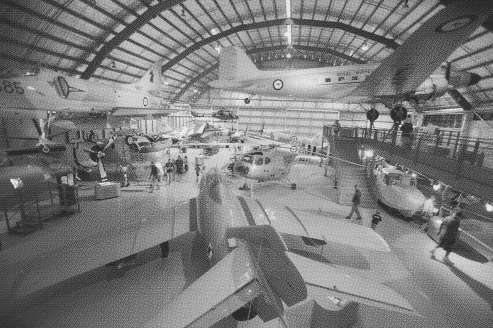- Author
- Periodical, Semaphore
- Subjects
- History - general, Biographies and personal histories, Ship histories and stories
- Tags
-
- RAN Ships
- None noted.
- Publication
- September 2007 edition of the Naval Historical Review (all rights reserved)
Opening of RANHC
The opening of the RANHC at Garden Island, Sydney, in 2005 is the most significant physical outcome so far of the RAN’s rejuvenated heritage management regime. The Centre provides the RAN with a multi-function capability for displaying its heritage to the public; however, it is only used for exhibition and public interaction. It is the NHC’s Main Repository at Spectacle Island that is the central pillar of the RAN’s heritage management process.
Until the advent of the RANHC, the only way to view the Collection was to visit the Main Repository. For that reason the NHC provided a display of artifacts at Spectacle Island in addition to performing its heritage storage functions; this is no longer the case and now Spectacle Island staff focus only on the museum cycle – accessioning, conservation/restoration, storage, exhibition planning and disposal. New collection management policies, operating procedures, storage methods and artifact handling processes have or are being introduced. Additional revenues being generated by the RAN Heritage Centre and allocations from the Navy Systems Command have had a significant and immediate positive effect on NHC conservation outcomes. Irreplaceable Navy artifacts, such as the ‘Rabaul Gun’ – the first enemy weapon captured by Australian Forces (the RAN Brigade) in WWI – and the Battle Ensign from HMAS Perth (I) from the Battle of Matapan in 1941, that were in great danger of total loss have been conserved and restored to exhibition standard.
The ex-munition depot buildings on Spectacle Island provide an ideal environment for Collection storage and, with planned improvements, even finer temperature and humidity control will be introduced, further assisting Collection preservation. Additional environmental controls will also be progressively introduced to the NHC Regional Collections and Exhibitions at HMAS Cerberus and HMAS Creswell.
Since 2003, major improvements across the NHC have been achieved but significant work remains to meet the approved outcomes of the NHMS. The RAN’s inconsistent approach to the management of its movable heritage is over but past neglect does mean the RAN is behind the other two Services and equivalent public institutions in achieving its heritage aims, and meeting its obligations.
Fleet Air Arm Museum
The collection management and exhibition gap is, however, closing with the RAN continuing to extend its heritage capabilities. On 1 September 2006, ownership of Australia’s Museum of Flight transferred to the RAN and came under the management of the NHC. Renamed the Fleet Air Arm Museum (FAAM), it will provide the RAN with an aviation conservation and exhibition institution of superior quality and, with the RAN Heritage Centre, provide further access for all Australians to view the heritage of their Navy.

(Image: RAN)
Over the coming months and years the exhibition spaces at the FAAM will be ‘navalised’ and updated, with greater emphasis being placed on the history of Australian naval aviation rather than the general aviation exhibition that the RAN inherited from Australia’s Museum of Flight. The FAAM collection of 35 aircraft is quite impressive and ranges from a Sea Fury and Firefly to an A4 Skyhawk and Wessex. The collection also includes many artifacts from individuals who have served in the Fleet Air Arm since its inception in 1948.
A future addition to the NHC is planned in 2007. The RAN’s intention is to transfer the management and heritage functions of the RAN Historic Flight (RANHF) from Maritime Command to Navy Systems Command. The Maritime Commander and Commander Australian Naval Air Group will retain authority for airworthiness and flying approval whilst the NHC will be responsible for daily management and the conservation/ restoration processes. The prospect of flying RANHF aircraft is an attractive option on many levels, not least of which is for Navy public relations. In order to minimise the risks attached to flying heritage aircraft, a full evaluation of the aims, processes, ongoing costs and procedures will be conducted prior to any recommendation to fly aircraft in this Flight.
The size and scope of Navy’s Collection makes it one of the largest single collections held by any public institution in Australia. Containing some 250,000 items, the Collection includes elements from all periods of the RAN’s history and includes all aspects of naval service. Ranging from large weapon and engineering systems to small personal items, some of the artifacts would be considered icons of the RAN whilst others tell poignantly of the experience of individual members during their service. Some of many examples include the diary of Able Seaman Weat, written during AE2’s transit of the Dardanelles on 25 April 1915, itself a remarkable story of how an individual can overcome personal fear when facing a common threat as part of a united ship’s company. Other artifacts with poignant stories to tell include the sword carried by Lieutenant Bond (2IC and later CO of the RAN Bridging Train) during the Gallipoli Campaign; and one of HMAS Canberra’s (I) life rings that was recovered from the water after Canberra’s loss and presented to Miss Estelle Clancy, whose fiancé was lost with the ship – she never married and kept the life ring for 60 years.




